List of Authors
>>About this blog
Recent blog post
|
[kimitaku]
December 31, 2015 13:03
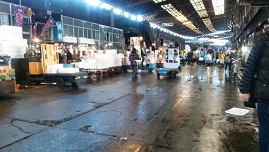 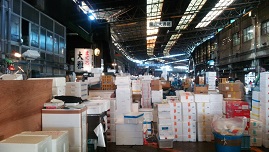
This is the scenery of Tsukiji Market Morning at the end of the year.
There is also a tarley that moves around with tantantin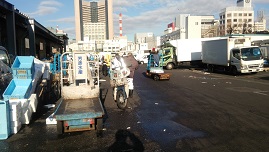
Carriages that are rushing ahead with progress
There is also a scream that can be heard from the shadow of the cargo
"Shiomachi Chaya" waits for a leisurely shipment.
The rush of the owner of the restaurant that carries the purchased fish
I can't see the end of next year.
Tsukiji Market will be fully relocated to Toyosu, Koto-ku in November next year.
Please take a look at the last scenery of the end of the year.
“Tsukiji Central Wholesale Market” was relocated from Nihonbashi in 1935 in 2016.
It begins with a history of 80 years.
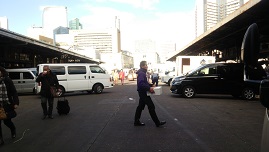
[Nojinya]
December 31, 2015 09:00
As announced in the blog post on December 3 (/archive/2015/12/post-2910.html), construction work for major renovations in the Heisei era (rebuilding of shrine office, etc.) has been underway since November. The grounds were surrounded by a white board with dumps and construction equipment, so I was worried that new year worshipping would not be able to go as it was, but last week, temporary construction was suspended and visitors could enter and exit from the main gate Was. 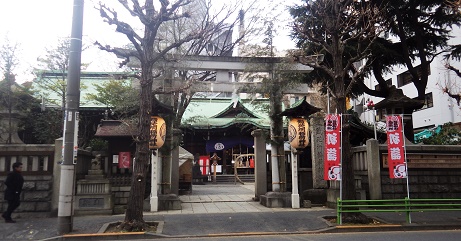 In front of main hall, Chinowa for New Year's Eve exorcism has already been prepared, and the part where shrine office was located remains surrounded by a white board, but as usual, this New Year seems to be safe. In front of main hall, Chinowa for New Year's Eve exorcism has already been prepared, and the part where shrine office was located remains surrounded by a white board, but as usual, this New Year seems to be safe.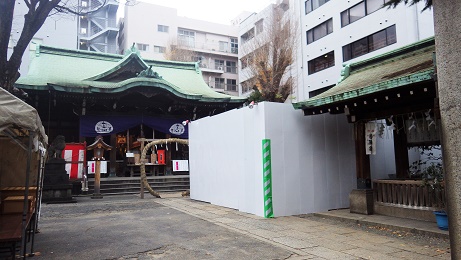
I would like to inform you as soon as possible because I thought it was a concern to our blog readers.
Added: The Kannaka Misogi (Kannaka Bathing Tournament) on January 10 (Sun) seems to be held at Tepposu Park from 11:00 am. 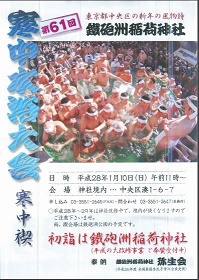 [Tepposhu Inari Shrine] [Tepposhu Inari Shrine]
Location 1-6-7 Minato, Chuo-ku, 104-0043, Japan
Phone: 03-3551-2647
Access Get off at the Tokyo bus "Higashi 15" and Edo bus "South circulation" gunshot stop. Chuo-ku community cycle "B01 gunshot children's park" cycle port soba.
[Nojinya]
December 29, 2015 09:00
More than a week  before before  the 92nd Hakone Ekiden Main Event of New Year's Day. There is a sign saying "Notice of Traffic Regulation" on Kajibashi Street, which tells you that this will be the Hakone Ekiden course on January 3 of the New Year. the 92nd Hakone Ekiden Main Event of New Year's Day. There is a sign saying "Notice of Traffic Regulation" on Kajibashi Street, which tells you that this will be the Hakone Ekiden course on January 3 of the New Year.  On the outbound route, start in front of the Yomiuri Shimbun headquarters in Otemachi, go straight south on Hibiya Street in Chiyoda-ku, but the last 10th ward on January 3 runs in Chuo-ku. In this way, Hakone Ekiden is a big event of the New Year, but in addition to running in Chuo-ku in the last ward, this race, in fact, has a deep connection with Chuo-ku. On the outbound route, start in front of the Yomiuri Shimbun headquarters in Otemachi, go straight south on Hibiya Street in Chiyoda-ku, but the last 10th ward on January 3 runs in Chuo-ku. In this way, Hakone Ekiden is a big event of the New Year, but in addition to running in Chuo-ku in the last ward, this race, in fact, has a deep connection with Chuo-ku.
Currently, the start / goal point is Otemachi, where the Yomiuri Shimbun headquarters is located, but from the postwar period until 1971, the headquarters of the Yomiuri Shimbun was in Ginza (currently the place   where Plantan Ginza is located), Ginza in Chuo-ku was exactly the start / goal of Hakone Ekiden. where Plantan Ginza is located), Ginza in Chuo-ku was exactly the start / goal of Hakone Ekiden.
Unfortunately, among the 21 teams participating this year, there is no university in Chuo-ku, but three of them are universities closely related to Chuo-ku in history.
One is Juntendo University. This university currently has campuses in Hongo and Sakura (Chiba Prefecture), but in 1838 (Tenpo 9), Taizen Sato founded Wada Juku in Yagenbori (currently Higashinihombashi) where he studied Dutch medicine. It is the origin.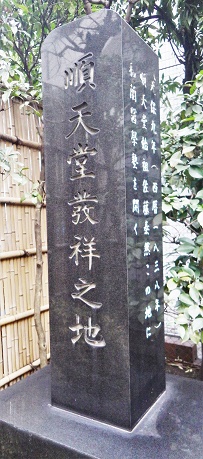
[The Monument of the birthplace of Juntendo in Yagenbori]
The second school is Chuo Gakuin. This is currently headquartered in Abiko City (Chiba Prefecture), but its origin is Nihonbashi Simple Commercial Night School, which was established in Shinkawa in 1900. After that, Nihonbashi Simple Commercial Night School became a Central Commercial School and Chuo Commerce Junior College, and junior colleges were abolished in 2000, but it is Chuo Gakuin University that participated this time.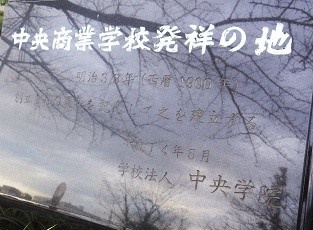
[Monument of the birthplace of Chuo Commercial School (Chuo Gakuin) in Shinkawa Park]
The third school is Aoyama Gakuin, who won last year. The current headquarters is also located in Shibuya, but its origins are Kogaku Gakusha, which was established in 1878 by Julius Sober in Tsukiji Akashicho. Kokyo Gakusha later merged with Azabu Women's Elementary School (later relocated to Akashicho to become a coastal girls' school) and Mikai Shin School in Yokohama Yamate, and became Aoyama Gakuin after going through Tokyo English School and Tokyo Eiwa School. 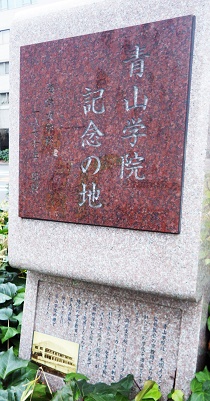 [Aoyama Gakuin Memorial Land in Akashicho] Monument [Aoyama Gakuin Memorial Land in Akashicho] Monument
The anchor runners who climbed Hibiya-dori, the 10th ward of the return trip on January 3, turn right at Baba Sanmon who climbed Hibiya-dori, the 10th ward of the return trip on January 3, turn right at Baba Sanmon  (Marunouchi, Chiyoda-ku) and enter Kajibashi-dori. After crossing (Marunouchi, Chiyoda-ku) and enter Kajibashi-dori. After crossing  the Shinkansen guard and Sotobori-dori St. and entering Chuo-ku, turn left in the Shinkansen guard and Sotobori-dori St. and entering Chuo-ku, turn left in  front of Tokyo Square Garden, enter Chuo-dori, cross Nihonbashi and front of Tokyo Square Garden, enter Chuo-dori, cross Nihonbashi and run through the ward at once to Tokiwa Bridge. Actually, this course was a different course until 17 years ago. In 1999, the course was changed to Kyobashi and Nihonbashi to commemorate the 88th anniversary of the Nihonbashi Bridge and the 75th Hakone Ekiden Convention. Along this line is the Meiji Seimeikan (Marunouchi, Chiyoda-ku), Mitsubishi Ichigokan Museum, Tokyo (Marunouchi), Dai-ichi Seimei Mutual Hall (Kyobashi), Meijiya (Kyobashi), Takashimaya (Nihonbashi), Mitsukoshi (Nihonbashi Muromachi), and the Bank of Japan (Honishimachi) are expected to have many traditional and beautiful buildings. It's a good course to enjoy the cityscape with support! run through the ward at once to Tokiwa Bridge. Actually, this course was a different course until 17 years ago. In 1999, the course was changed to Kyobashi and Nihonbashi to commemorate the 88th anniversary of the Nihonbashi Bridge and the 75th Hakone Ekiden Convention. Along this line is the Meiji Seimeikan (Marunouchi, Chiyoda-ku), Mitsubishi Ichigokan Museum, Tokyo (Marunouchi), Dai-ichi Seimei Mutual Hall (Kyobashi), Meijiya (Kyobashi), Takashimaya (Nihonbashi), Mitsukoshi (Nihonbashi Muromachi), and the Bank of Japan (Honishimachi) are expected to have many traditional and beautiful buildings. It's a good course to enjoy the cityscape with support!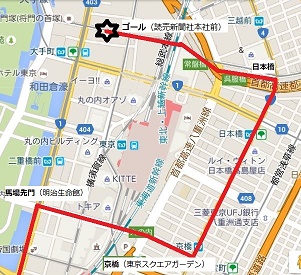
Last year's Hakone Ekiden has been reported in detail by correspondent Tataro Edo with photos (/archive/2015/01/post-2270.html).
Monument of the birthplace of Juntendo
Location 2-6-8, Higashi Nihonbashi, Chuo-ku, 103-0004, Japan (Yagenbori Fudoin precinct)
[Monument of the birthplace of the Central Commercial School]
Location 1-32, Shinkawa, Chuo-ku, 104-0033, Japan (in Shinkawa Park)
[Monument of Aoyama Gakuin Memorial Land]
Location 6-26 Akashicho, Chuo-ku, 104-0044, Japan (in front of Nichirei Akashicho Building)
[Nojinya]
December 28, 2015 12:00
How many more sleeps are New Year's Day. 。 。
Blog readers, are you ready for New Year's cards? Next year is the year of the monkey. "Shin" seems to mean "the fruit will mature and become clear", and next year seems to be "the year when the results of efforts will be fruitful." I want to do my best positively.
Well, just before I went to Kyobashi for dinner with my family, I went to a post office near the restaurant to buy a plain inkjet New Year's card while talking about such things.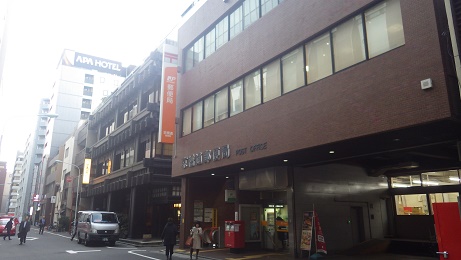
[Kyobashi-dori Post Office in Kyobashi]
There were many people at the post office seeking New Year's cards in the same way, so if you wait for your turn, the son of the "question kid " "  will ask simple questions as usual. will ask simple questions as usual.
"This post office is called Kyobashi-dori, but before this, there was an absence delivery slip in my home, and it was Kyobashi Post Office that went to receive a parcel from my aunt. I know "Kyobashi-dori Post Office" in Kyobashi, but why is that (of Harumi-dori St.) not "Tsukiji Post Office" but "Kyobashi Post Office"?"
~ Kyobashi-dori Post Office is a post office located a little on the road opposite Tokyo Square Garden across Chuo-dori toward Showa-dori. This street is between Kajibashi Street and Kyobashi Takegashi Street, and it seems that this area was once called Guashicho, Minami Temmacho, etc., but there is no particular street name at present ~~
"Yes, this Kyobashi-dori Post Office means a post office in Kyobashi. I wondered if the name of the street in front of me could be called "Kyobashi Street", but it doesn't seem to be particularly named on the street. " 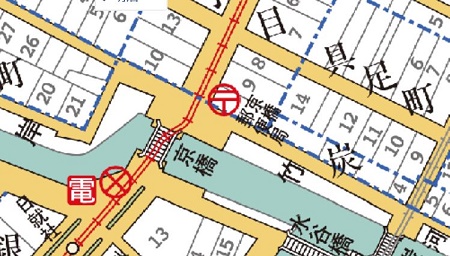 [Goo Map near Kyobashi in Meiji period] ⇒A little north of Kyobashi in the center, "Kyobashi Post Office (the predecessor of the current Kyobashi Dori Post Office?) You can see it. [Goo Map near Kyobashi in Meiji period] ⇒A little north of Kyobashi in the center, "Kyobashi Post Office (the predecessor of the current Kyobashi Dori Post Office?) You can see it.
~-I asked the Japan Post General Affairs Department about the origin of Kyobashi-dori Post Office. Kyobashi-dori Post Office was at the beginning of Showa (1929?) It was said that it was founded, but unfortunately the origin of the name was not known at the post office. On the other hand, if you look at the old map of Meiji period (goo map old map), you can see that there was a slightly smaller post office called Kyobashi Post Office near Kitazume in Kyobashi. It's just an estimate, but this post office also started as a Kyobashi post office, but it's confusing that there are two post offices with the same name, so at the beginning of Showa (near Kyobashi) "Kyobashi-dori Post Office" Isn't it that you changed the name (if you know about this point, I would be grateful if you could tell me more, and I would like to investigate it with the question monk.) ~ 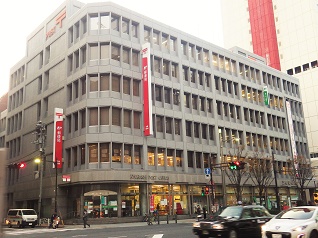 [Kyobashi Post Office along Harumi-dori St.] [Kyobashi Post Office along Harumi-dori St.]
「。 。 。 "Kyobashi Post Office" may have meant the post office of "Kyobashi Ward" when Chuo-ku was a separate ward in Kyobashi Ward and Nihonbashi Ward in the past. This post office is still a large post office that collects and distributes, but since it has long been a post office that has been the center of this area (formerly Kyobashi Ward), it may have been named Kyobashi Post Office. "
If you look at the old map of Meiji period (goo map old map), you can see the name "Kyobashi Post Office" at the current location of Tsukiji 4-chome. Looking at the map of the early Meiji era (a map of another Ministry of Home Affairs, etc.), it has not yet become a post office because it has not yet become a post office for "Navy territory" or "Agriculture, Commerce and Industry Ministry Land". ) It is presumed that the Kyobashi Post Office was established in Japan. ~~
[Goo Map near Tsukiji in Meiji period] ⇒You can see the "Kyobashi Post Office" in the center of the left. The pink land at the lower right is Tsukiji Honganji Temple, and the red line is Toden.
"Hey, Kyobashi Ward is a cool name!"
"The current Chuo-ku was established in 1947, and I know that Kyobashi-ku and Nihonbashi-ku were together to form Chuo-ku. Now it is called Tokyo's 23 wards, but in the Meiji era there were 50 wards, the era of 100 wards (precisely, there were 11 and 103 small wards and called O ward small wards), the era of 15 wards, The era of the 35 wards and the number of wards have changed significantly. Kyobashi Ward and Chuo-ku were born in 1878 when they became 15 wards. "
"By the way, do you know that Chuo-ku has a deep connection with the history of postal mail in Japan? Nihonbashi was the first post office in Japan, and now it is called the Postal Services Agency at an external office of the Ministry of Internal Affairs and Communications, but the Ministry of Communications, which was the source of it, was able to go to Kibikicho (now Ginza Junior High School, Ginza Post Office) in Meiji period."
Just because the order of waiting here came, the story ended, but his son also seemed interested in the history of Chuo-ku and mail. It seems that you will go to the Kyobashi Library and the Postal Museum in Oshiage (Sumida-ku) during the winter vacation to check various things.
[Kyobashi-dori Post Office]
Location 3-6-3 Kyobashi, Chuo-ku, 104-0031, Japan
Phone: 03‐3561‐1086
Business hours From 9:00 to 18:00 (Saturdays and holidays)
[Kyobashi Post Office]
Location 4-2-2 Tsukiji, Chuo-ku, 104-8799, Japan
Phone: 03‐5546‐1068
Business hours From 9:00 to 19:00 (Saturday is ~ 17:00, Sundays and holidays ~ 12:30)
[Dimini ☆ Cricket]
December 27, 2015 16:00
It is a state of hanging pine trees at Ginza Shochiku Square (1-13-1 Tsukiji), just shortly after crossing Mannen Bridge and crossing the Metropolitan Expressway from Kabukiza.
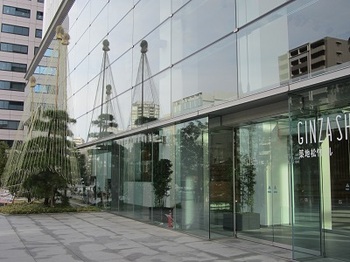
Snow hanging is to hold branches with ropes so that tree branches do not break due to the adhesion of snow in winter, but it is famous for those from Kenrokuen in Kanazawa, snowy country.
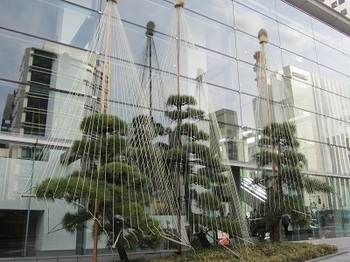
In the snowy country, it is both practical and decoration, but in Tokyo where there is little snow, it seems that it was adopted as a decoration to add a touch to the garden, and in Chuo-ku, the suspension of snow at the Hamarikyu Onshi Garden is also held around mid-November as a winter tradition. Will be
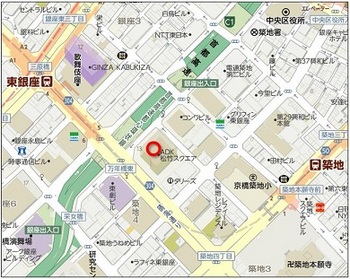
I didn't notice until now, but there was also snow hanging in a familiar place.
There is also a bamboo planting area in this square, and one person convinced that it is "Shochiku" with pine and bamboo hanging from snow. 
The red circle on the map above is Ginza Shochiku Square.
     
[Nojinya]
December 25, 2015 09:00
The Chuo-ku Community Cycle (CC C) has been taking care of every day except on rainy days since its start in October. It is very active not only in commuting but also in shopping and sightseeing in the city (Blog article "Chuo-ku version Vélib (community cycle)-Part 2-" /archive / 2015/10/velib-1.html) C) has been taking care of every day except on rainy days since its start in October. It is very active not only in commuting but also in shopping and sightseeing in the city (Blog article "Chuo-ku version Vélib (community cycle)-Part 2-" /archive / 2015/10/velib-1.html)
Such a CCC has announced that it will start mutual use in four wards (Chuo-ku, Chiyoda-ku, Minato-ku, Koto-ku) that have introduced a community cycle in Tokyo in February next year (the end of April There is a possibility of extension depending on experiments and usage results for a limited time). has announced that it will start mutual use in four wards (Chuo-ku, Chiyoda-ku, Minato-ku, Koto-ku) that have introduced a community cycle in Tokyo in February next year (the end of April There is a possibility of extension depending on experiments and usage results for a limited time). 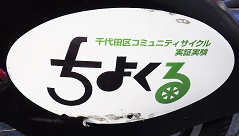 This is good news This is good news ! Even now, if you use CCC ! Even now, if you use CCC , you will be able to travel in the wide ward from Ginza / Tsukiji in the south and Harumi Wharf to Higashinihombashi in the north, and traveling within the ward has become very convenient, but there are , you will be able to travel in the wide ward from Ginza / Tsukiji in the south and Harumi Wharf to Higashinihombashi in the north, and traveling within the ward has become very convenient, but there are still many ports in the ward (Ginza still many ports in the ward (Ginza , Hakozaki TCAT , Hakozaki TCAT , southern Tsukiji, southern part of Tsuchiji, etc.) , southern Tsukiji, southern part of Tsuchiji, etc.) 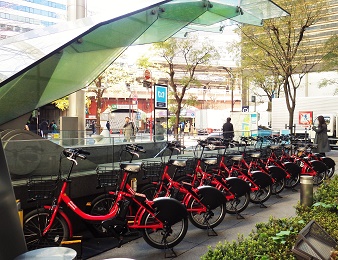 Tokyo International Forum Port in front of Tokyo International Forum Port in front of JR and Yurakucho Subway Station JR and Yurakucho Subway Station
On the other hand, if you go to Plantan Ginza in the west area of Ginza, it is closer to stopping at the Tokyo International Forum (Marunouchi 3-chome, Chiyoda-ku) port of the Chiyoda-ku Community Cycle ("Chiyori ") than Tokyo Square Garden (B02) on Kyobashi / Yanagi-dori St., which is a port in the ward, and ") than Tokyo Square Garden (B02) on Kyobashi / Yanagi-dori St., which is a port in the ward, and it is more convenient to use the Marunouchi 1 port in the Chiyoda-ku. it is more convenient to use the Marunouchi 1 port in the Chiyoda-ku.
The other day, there was an errand to go to Jimbo-cho, so I recently registered a new one (currently, I can't use it if I so I recently registered a new one (currently, I can't use it if I can register can register  with CCC, and separate registration is required) I borrowed it from the port of Maru Building . After February, it will be possible to go directly from the port in the city to the Jimbocho Mitsui Building (Chiyoda-ku) without the hassle of double registration and transfer. Furthermore, as a sightseeing correspondent in Chuo-ku, people outside the ward, such as Koto-ku, Minato-ku, and Chiyoda-ku, look at the Chuo-ku sightseeing correspondent blog and visit Chuo-ku for sightseeing and shopping. I think it will increase, so I'm looking forward to starting mutual entry in February! with CCC, and separate registration is required) I borrowed it from the port of Maru Building . After February, it will be possible to go directly from the port in the city to the Jimbocho Mitsui Building (Chiyoda-ku) without the hassle of double registration and transfer. Furthermore, as a sightseeing correspondent in Chuo-ku, people outside the ward, such as Koto-ku, Minato-ku, and Chiyoda-ku, look at the Chuo-ku sightseeing correspondent blog and visit Chuo-ku for sightseeing and shopping. I think it will increase, so I'm looking forward to starting mutual entry in February!
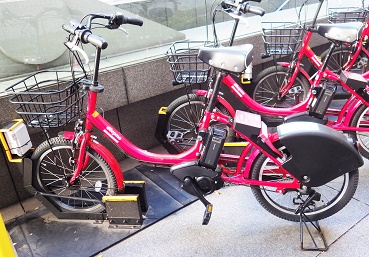 [Bicycle [Bicycle  for use] ⇒The color is the same red, but it was a bit tight for use] ⇒The color is the same red, but it was a bit tight er than CCC. er than CCC.
Furthermore, in the future, not only these four wards, but also Chuo-ku has a deep connection from the viewpoint of sightseeing and the history of Edo, and I hope that the introduction  of community cycles will be promoted in neighboring Taito Ward and Sumida-ku. Docomo Bikeshare Co., Ltd., a business operator, please do your best! of community cycles will be promoted in neighboring Taito Ward and Sumida-ku. Docomo Bikeshare Co., Ltd., a business operator, please do your best!
[Chuo-ku community cycle, Chiyoru, Minato-ku bicycle sharing, Koto-ku coastal area community cycle homepage]
CCC: http://docomo-cycle.jp/chuo/ http://docomo-cycle.jp/chuo/
I'm afraid : http://docomo-cycle.jp/chiyoda/ : http://docomo-cycle.jp/chiyoda/
Minato-ku Bicycle Sharing : http://docomo-cycle.jp/minato/ : http://docomo-cycle.jp/minato/
Coastal area of Koto-ku CC : http://docomo-cycle.jp/koto/sitemap/ : http://docomo-cycle.jp/koto/sitemap/
Docomo Bike Share Co., Ltd.: http://www.d-bikeshare.com/
|
Links
|




 In front of main hall, Chinowa for New Year's Eve exorcism has already been prepared, and the
In front of main hall, Chinowa for New Year's Eve exorcism has already been prepared, and the 

 On the outbound route, start in front of the Yomiuri Shimbun headquarters in Otemachi, go straight south on Hibiya Street in Chiyoda-ku, but the last 10th ward on January 3 runs in Chuo-ku.
On the outbound route, start in front of the Yomiuri Shimbun headquarters in Otemachi, go straight south on Hibiya Street in Chiyoda-ku, but the last 10th ward on January 3 runs in Chuo-ku.





 [Kyobashi Post Office along Harumi-dori St.]
[Kyobashi Post Office along Harumi-dori St.]



 This is good news
This is good news Tokyo International Forum Port in front of
Tokyo International Forum Port in front of

